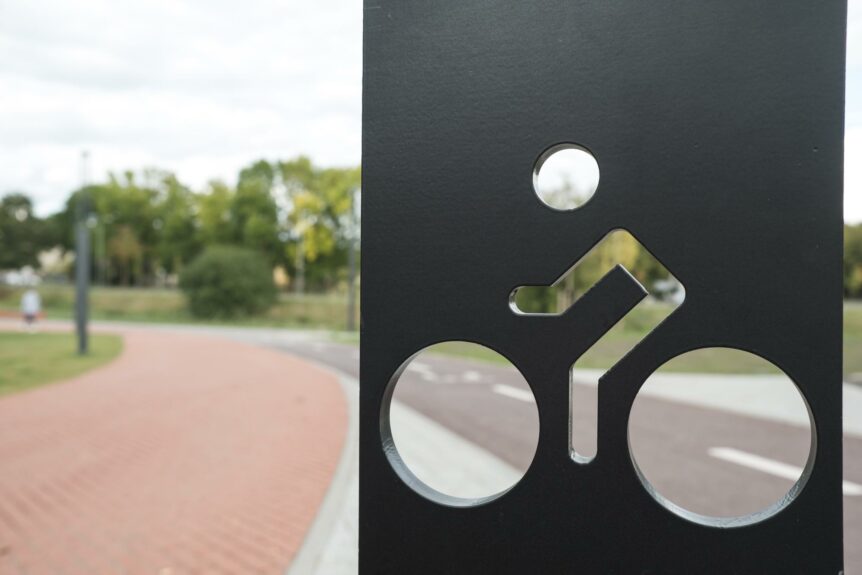This is a four-country investigation into faulty cycling infrastructure built using EU structural and cohesion funds. By ‘faulty’ we mean unsafe, disjointed, or harmful to other environmental causes, such as protection of biodiversity. The journalistic investigation, supported by Journalismfund.eu, later turned into my fellowship project at the European University Institute.
How it started
The idea to investigate EU investment being used for faulty infrastructure was born when I shared some of the most absurd solutions developed in Malta with my Lithuanian friends, and they said there were plenty of unusable cycling tracks and lanes in Lithuania, too. Is this an international trend?
Cycling is indispensable in the European Union’s efforts to reduce emissions – this was clear from the European Urban Mobility Framework a year ago. But as policymakers set ambitious targets, transport is emitting more than before, using a third of the EU’s energy, and keeping Europe dependent on Russian oil. EU’s structural and cohesion funds are supposed to help. But when cyclists roll onto cycle paths built with these funds, they find an obstacle course: patchy, poorly maintained, sometimes too narrow paths leading nowhere.
I pitched the idea to look into this at the Media4Change and European Dialogue Mediathon in Slovakia in 2021. Two people joined my idea, one eventually dropped out, but Czech journalist Barbora Janauerová stayed. I later invited Romanian journalist Zoltán Sipos to join our team, and together we applied for a Journalismfund.eu environmental journalism grant. In spring we were awarded the funding — I was in charge of coordinating the project and also covered two countries. To our delight, Staffan Dahllöf agreed to be our mentor.
What we did
Over the months we talked to experts, officials, NGOs, and dozens of cyclists in four countries. We also reviewed tendering documents, a sample of EU-funded projects, and some of the actual cycle paths and lanes.
Obviously, our countries are very differerent, among other things, also in terms of access to data and government responsiveness. But the trends were clear. From tiny Malta, which benefited from three EU instruments to produce a basic transport wishlist, to Romania – one of the largest beneficiaries of EU spending on cycling and pedestrian infrastructure – our team found vague standards and opportunistic planning, driven not by cyclists’ needs but by administrations’ convenience.
Our key publications in English appeared in the EUobserver:
- How EU funds for bike infrastructure are being misused — the main discovery here is that in all countries EU funding was used for infrastructure that is not accessible to different parts of the population and, instead of promoting road safety, drives conflicts;
- How EU funded bike infrastructure is used to ‘greenwash’ new tarmac; — the main finding here is that cycling infrastructure is in some cases built at the expense of urban greenery or lumped with other transport works to greenwash mainstream road projects that favour cars;
- Cycling’s legislative chaos: do they know what they’re building? — here our focus was on legislative conflicts, which prevent building usable bike lanes in some localities. I also revealed how Malta’s government got various Western contractors to praise the development of its sustainable urban mobility plan, when in fact the plan was hatching for over five years and was eventually pushed out (as a milestone for the Recovery & Resilience Facility) in a way that disappointed local cyclists.
The first publication of the project aired in October on LRT, the Lithuanian public radio. I am grateful to Vaida Pilibaitytė, the show’s host, for her kind mentorship in all things audio. Lithuanian speakers can hear the story on the Vienkartinė planeta show.
Barbora Janauerová’s article on cycling safety issues in Czechia was published by A2larm magazine. Zoltán Sipos wrote an article in Hungarian for Átlátszo Erdély. It was also translated into Romanian.
For those who are interested in Lithuania, I also have a somewhat primitive map, which I used to organise project selection and analyse the overlap (or lack thereof) of cyclists’ needs and authorities’ responses. The skulls and bones signify cyclists death — big thanks to the Lithuanian Police spokespersons for the data, which I converted to the Google Maps format myself. The drawn coloured strips are my sample of EU-funded projects. If you click on them, you will find some public procurement data. The axes stand for environmental sacrifices for the sake of cycling paths — this information was crowdsourced. If you build upon this map or information contained here, please let me know!
Kornelija Ukolovaitė fact-checked my reporting from Lithuania and Brussels. The Daphne Caruana Galizia Foundation provided legal review for my reporting from Malta.
But that was not the end
In January, the European Parliament’s TRAN committee proposed a resolution on cycling, emphasising adherence to safety standards. The resolution was adopted on 16 February.
Meanwhile, I received a Policy Leader Fellowship to spend a semester in Florence. I had a chance to develop a series of written pieces and a case study report on the multi-level governance of cycling policy in the EU:
- I wrote about the issues of shared responsibility for cycling in a blog post on EUIdeas;
- I also requested data from Maltese and Lithuanian authorities and wrote about policy responses to bike theft for la Repubblica: the articles came out in Italian and in English.
- I wrote a case study, with possible scenarios for moving forward, which is now available for academics at the European University Institute to use.
I am still interested in reporting on cycling issues: thefts (I checking out recommend these investigations by a different team in Ireland), safety and investment. Happy to collaborate on journalistic investigations or present at online and in-person events.
Cover photo: Justinas Stonkus


